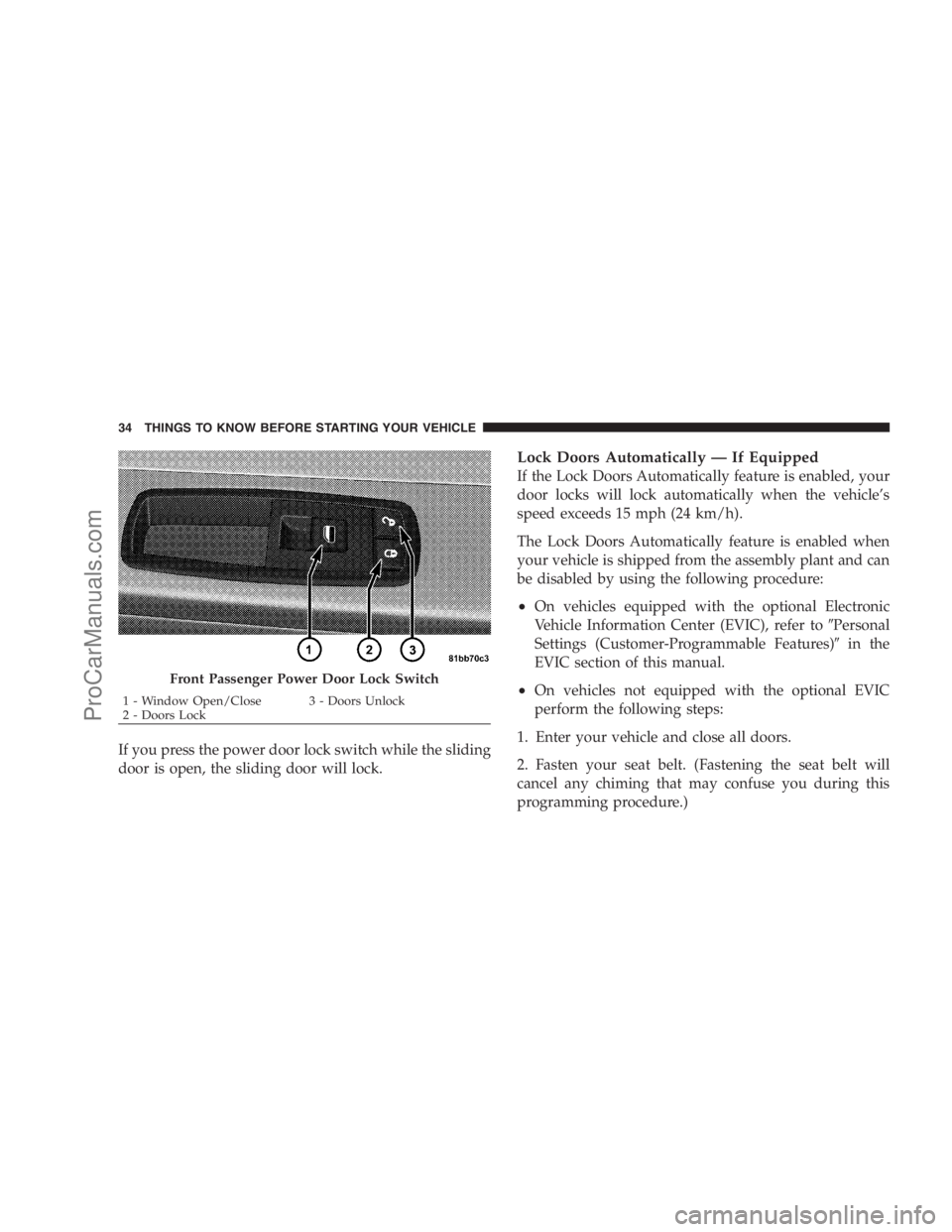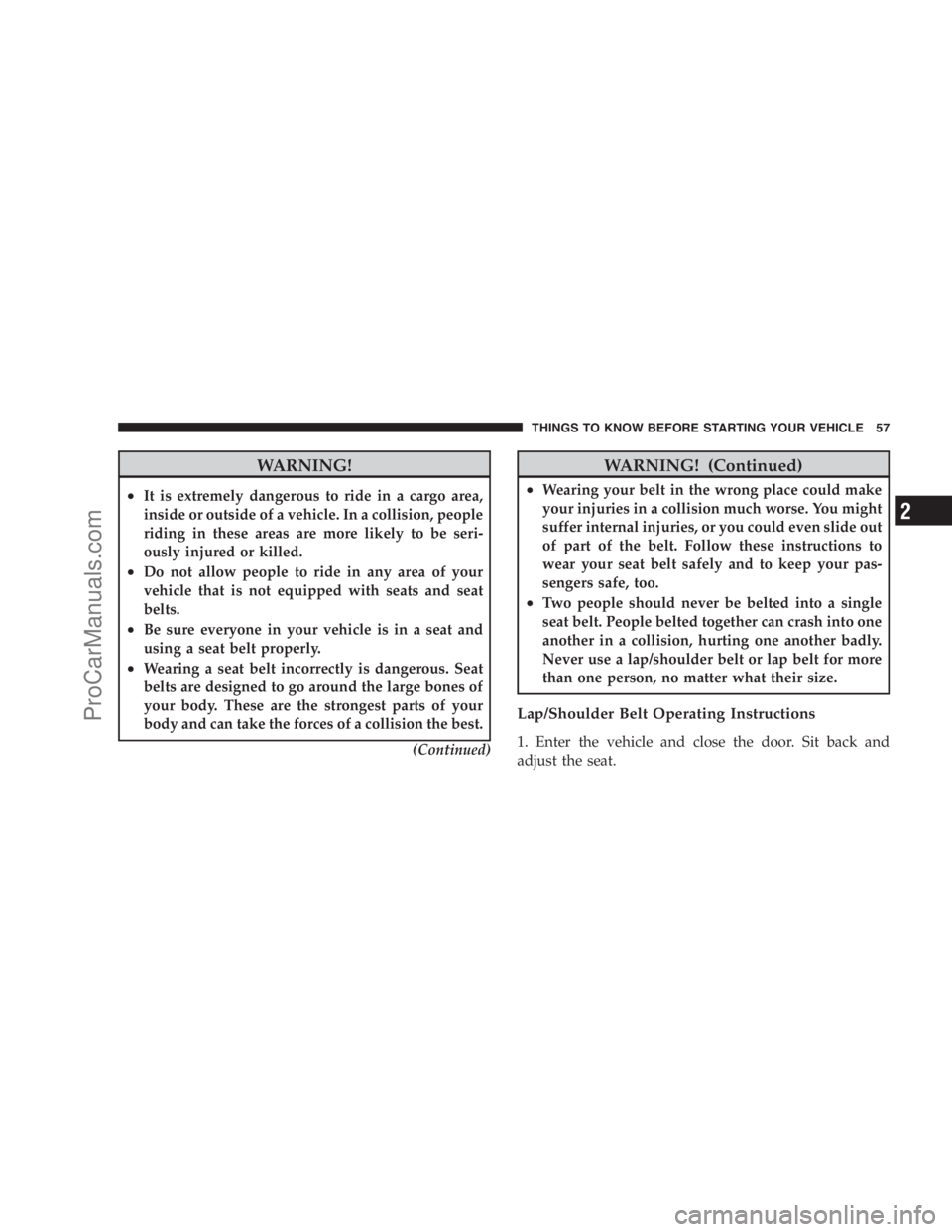Page 12 of 534

�Sliding Side Door....................... 42
▫Power Sliding Side Door — If Equipped..... 43
▫Sliding Side Door Child Protection Lock..... 47
�Liftgate.............................. 49
▫Power Liftgate — If Equipped............ 50
�Storage Bin Safety Warning................ 53
▫Safety Warning....................... 53
�Occupant Restraints..................... 55
▫Lap/Shoulder Belts.................... 56
▫Automatic Locking Retractors (ALR) Mode
— If Equipped........................ 62
▫Seat Belt Pretensioners.................. 62▫Enhanced Seat Belt Use Reminder System
(BeltAlert�).......................... 63
▫Seat Belts And Pregnant Women........... 64
▫Seat Belt Extender..................... 64
▫Supplemental Restraint System (SRS) -
Airbag............................. 65
▫Airbag System Components.............. 66
▫Front Seat Airbag Features............... 66
▫Airbag Deployment Sensors And Controls.... 70
▫Event Data Recorder (EDR).............. 76
▫Integrated Child Booster Seat — If Equipped . . 78
▫Integrated Child Seat — If Equipped........ 80
▫Child Restraints....................... 81
10 THINGS TO KNOW BEFORE STARTING YOUR VEHICLE
ProCarManuals.com
Page 36 of 534

If you press the power door lock switch while the sliding
door is open, the sliding door will lock.
Lock Doors Automatically — If Equipped
If the Lock Doors Automatically feature is enabled, your
door locks will lock automatically when the vehicle’s
speed exceeds 15 mph (24 km/h).
The Lock Doors Automatically feature is enabled when
your vehicle is shipped from the assembly plant and can
be disabled by using the following procedure:
•On vehicles equipped with the optional Electronic
Vehicle Information Center (EVIC), refer to�Personal
Settings (Customer-Programmable Features)�in the
EVIC section of this manual.
•On vehicles not equipped with the optional EVIC
perform the following steps:
1. Enter your vehicle and close all doors.
2. Fasten your seat belt. (Fastening the seat belt will
cancel any chiming that may confuse you during this
programming procedure.)Front Passenger Power Door Lock Switch
1 - Window Open/Close 3 - Doors Unlock
2 - Doors Lock 34 THINGS TO KNOW BEFORE STARTING YOUR VEHICLE
ProCarManuals.com
Page 38 of 534

The Unlock Doors Automatically On Exit feature can be
enabled or disabled by performing the following proce-
dure:
1. Enter your vehicle and close all doors.
2. Fasten your seat belt. (Fastening the seat belt will
cancel any chimes that may be confusing during this
programming procedure.)
3. Insert the key into the ignition switch.
4. Within 15 seconds, cycle the ignition key from the
LOCK position to the ON/RUN position a minimum of
four times ending in the LOCK position(do not start the
engine).
5. Within 30 seconds, press the driver’s door lock switch
in the UNLOCK direction.
6. A single chime will sound to indicate the feature has
been changed.7. To reactivate this feature, repeat the above steps.
8. If a chime is not heard, the program mode was
canceled before the feature could be changed. If neces-
sary, repeat the above procedure.
The Unlock Doors Automatically On Exit feature can be
reactivated by repeating the above mentioned procedure
or by performing the procedure in the EVIC, Customer
Programmable Features section on vehicles so equipped.
NOTE:Use the Lock Doors Automatically at 15 mph
(24 km/h) and Unlock Doors Automatically On Exit
features in accordance with local laws.
Remote Power Unlock On First Press — If
Equipped
The Remote Power Unlock On First Press feature lets you
program the system to unlock either the driver’s side
door or all doors on the first press of the UNLOCK
button on the transmitter.
36 THINGS TO KNOW BEFORE STARTING YOUR VEHICLE
ProCarManuals.com
Page 57 of 534

OCCUPANT RESTRAINTS
Some of the most important safety features in your
vehicle are the restraint systems:
•Three-point lap and shoulder belts for all seating
positions
•Pretensioning and load-limiting retractors for the front
seat belts
•Advanced multistage driver and new active-vent front
passenger airbags
•Supplemental side airbags that span the front, second,
and third row seating for the driver and passengers
seated next to a window.
•An energy-absorbing steering column and steering
wheel
•Knee bolsters/blockers for front seat occupants
•Front seat belt retractors incorporate pretensioners to
enhance occupant protection by managing occupant
energy during an impact event.
•All seat belt systems (except the driver’s, Swivel n’ Go,
and third row center position) include Automatic
Locking Retractors (ALRs), which lock the seat belt
webbing into position by extending the belt all the
way out and then adjusting the belt to the desired
length to restrain a child seat or secure a large item in
a seat.
If you will be carrying children too small for adult-size
seat belts, your seat belts or the Lower Anchors and
Tether for CHildren (LATCH) feature also can be used to
hold infant and child restraint systems.
NOTE:The front airbags have a multistage inflator
design. This allows the airbag to have different rates of
inflation that are based on collision severity.
THINGS TO KNOW BEFORE STARTING YOUR VEHICLE 55
2
ProCarManuals.com
Page 58 of 534

Please pay close attention to the information in this
section. It tells you how to use your restraint system
properly to keep you and your passengers as safe as
possible.
WARNING!
In a collision, you and your passengers can suffer
much greater injuries if you are not properly buckled
up. You can strike the interior of your vehicle or other
passengers, or you can be thrown out of the vehicle.
Always be sure you and others in your vehicle are
buckled up properly.
Buckle up even though you are an excellent driver, even
on short trips. Someone on the road may be a poor driver
and cause a collision that includes you. This can happen
far away from home or on your own street.Research has shown that seat belts save lives, and they
can reduce the seriousness of injuries in a collision. Some
of the worst injuries happen when people are thrown
from the vehicle. Seat belts reduce the possibility of
ejection and the risk of injury caused by striking the
inside of the vehicle.Everyone in a motor vehicle should
be belted at all times.
Lap/Shoulder Belts
All seats in your vehicle are equipped with lap/shoulder
belts.
The belt webbing in the retractor is designed to lock
during very sudden stops or collisions. This feature
allows the shoulder part of the belt to move freely with
you under normal conditions. But in a collision, the belt
will lock and reduce the risk of your striking the inside of
the vehicle or being thrown out.
56 THINGS TO KNOW BEFORE STARTING YOUR VEHICLE
ProCarManuals.com
Page 59 of 534

WARNING!
•It is extremely dangerous to ride in a cargo area,
inside or outside of a vehicle. In a collision, people
riding in these areas are more likely to be seri-
ously injured or killed.
•Do not allow people to ride in any area of your
vehicle that is not equipped with seats and seat
belts.
•Be sure everyone in your vehicle is in a seat and
using a seat belt properly.
•Wearing a seat belt incorrectly is dangerous. Seat
belts are designed to go around the large bones of
your body. These are the strongest parts of your
body and can take the forces of a collision the best.
(Continued)
WARNING! (Continued)
•Wearing your belt in the wrong place could make
your injuries in a collision much worse. You might
suffer internal injuries, or you could even slide out
of part of the belt. Follow these instructions to
wear your seat belt safely and to keep your pas-
sengers safe, too.
•Two people should never be belted into a single
seat belt. People belted together can crash into one
another in a collision, hurting one another badly.
Never use a lap/shoulder belt or lap belt for more
than one person, no matter what their size.
Lap/Shoulder Belt Operating Instructions
1. Enter the vehicle and close the door. Sit back and
adjust the seat.
THINGS TO KNOW BEFORE STARTING YOUR VEHICLE 57
2
ProCarManuals.com
Page 60 of 534
2. The seat belt latch plate is near the seatback of the
front seats and next to your arm in the rear seats. Grasp
the latch plate and pull out the belt. Slide the latch plate
up the webbing as far as necessary to allow the belt to go
around your lap.WARNING!
•A belt that is worn under your arm is very danger-
ous. Your body could strike the inside surfaces of
the vehicle in a collision, increasing head and neck
injury. A belt worn under the arm can cause
internal injuries. Ribs aren’t as strong as shoulder
bones. Wear the belt over your shoulder so that
your strongest bones will take the force in a
collision.
•A shoulder belt placed behind you will not protect
you from injury during a collision. You are more
likely to hit your head in a collision if you do not
wear your shoulder belt. The lap and shoulder belt
are meant to be used together.
Pulling Out Belt and Latch Plate
58 THINGS TO KNOW BEFORE STARTING YOUR VEHICLE
ProCarManuals.com
Page 61 of 534
3. When the belt is long enough to fit, insert the latch
plate into the buckle until you hear a “click”.WARNING!
•A belt that is buckled into the wrong buckle will
not protect you properly. The lap portion could ride
too high on your body, possibly causing internal
injuries. Always buckle your belt into the buckle
nearest you.
•A belt that is too loose will not protect you as well.
In a sudden stop you could move too far forward,
increasing the possibility of injury. Wear your seat
belt snugly.
Inserting Latch Plate into Buckle
THINGS TO KNOW BEFORE STARTING YOUR VEHICLE 59
2
ProCarManuals.com